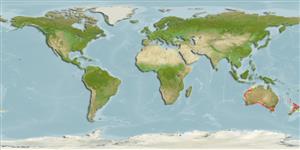>
Stomiiformes (Lightfishes and dragonfishes) >
Sternoptychidae (Marine hatchetfishes) > Sternoptychinae
Etymology: Polyipnus: Greek, poly = a lot of + Greek, ipnos = lanterns.
Environment: milieu / climate zone / depth range / distribution range
पारिस्थितिकी
समुद्री बेनथोपिलाजिक. Temperate
Southwest Pacific: restricted to the Tasman Sea off the east coast of Australia and continental slope areas of New Zealand.
आकार / वज़न / Age
Maturity: Lm ? range ? - ? cm
Max length : 8.2 cm SL पुल्लिंग / अलिंग; (Ref. 26382)
A benthic species (Ref. 75154) which occurs on the continental shelf and slope (Ref. 7300, 75154).
Life cycle and mating behavior
परिपक्व अवधि | पुनरुत्पत्ति | मछलीऔ का अंडे देना | अंडे | Fecundity | लार्वा
Harold, A.S., 1994. A taxonomic revision of the sternoptychid genus Polyipnus (Teleostei: Stomiiformes) with an analysis of phylogenetic relationships. Bull. Mar. Sci. 54(2):428-534. (Ref. 26382)
IUCN Red List Status (Ref. 130435)
Threat to humans
Harmless
Human uses
अधिक जानकारी
आम नामउपशब्दचपायचयपरभक्षीईकोटोकसीकोलौजीपुनरुत्पत्तिपरिपक्व अवधिमछलीऔ का अंडे देनाSpawning aggregationFecundityअंडेEgg development
Age/Size
बाढ़
Length-weight
Length-length
Length-frequencies
मौरफोमैटरिक्स
आकृति विज्ञान
लार्वा
लारवल गतिकी
भर्ती
बहुतायत
BRUVS
संदर्भजलीयकृषिजलीयकृषि रूपरेखाखींचआनुवंशिकीElectrophoresesहैरेटिबिलटीबीमारीप्रक्रमणNutrientsMass conversion
सहयोगीयोतस्वीरेStamps, Coins Misc.ध्वनिसिगुयटिरारफ्तारतैरने के प्रकारगिल क्षेत्रOtolithsदिमागदृष्टि
साधन
Special reports
Download XML
इंटरनेट स्रोत
Estimates based on models
Preferred temperature (Ref.
123201): 13 - 23.3, mean 15.3 °C (based on 79 cells).
Phylogenetic diversity index (Ref.
82804): PD
50 = 0.5000 [Uniqueness, from 0.5 = low to 2.0 = high].
Bayesian length-weight: a=0.02239 (0.01007 - 0.04976), b=2.98 (2.79 - 3.17), in cm total length, based on LWR estimates for this (Sub)family-body shape (Ref.
93245).
Trophic level (Ref.
69278): 3.3 ±0.3 se; based on size and trophs of closest relatives
लौटाव (Ref.
120179): ऊंचा, न्यूनतम जनसंख्या दुगनी समय अवलागत 15 महीने। (Preliminary K or Fecundity.).
Fishing Vulnerability (Ref.
59153): Low vulnerability (10 of 100).
